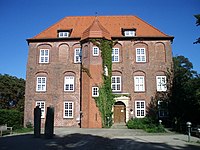
Neuengamme was a network of Nazi concentration camps in Northern Germany that consisted of the main camp, Neuengamme, and more than 85 satellite camps. Established in 1938 near the village of Neuengamme in the Bergedorf district of Hamburg, the Neuengamme camp became the largest concentration camp in Northwest Germany. Over 100,000 prisoners came through Neuengamme and its subcamps, 24 of which were for women. The verified death toll is 42,900: 14,000 in the main camp, 12,800 in the subcamps, and 16,100 in the death marches and bombings during the final weeks of World War II. Following Germany's defeat in 1945, the British Army used the site as an internment camp for SS and other Nazi officials. In 1948, the British transferred the land to the Free Hanseatic City of Hamburg, which summarily demolished the camp's wooden barracks and built in its stead a prison cell block, converting the former concentration camp site into two state prisons operated by the Hamburg authorities from 1950 to 2004. Following protests by various groups of survivors and allies, the site now serves as a memorial. It is situated 15 km southeast of the centre of Hamburg.

Aufseherin[ˈaʊ̯fˌzeːəʁɪn] was the position title for female guards in Nazi concentration camps during the Holocaust. Of the 50,000 guards who served in Nazi concentration camps, about 5,000 were women. In 1942, the first female guards arrived at Auschwitz and Majdanek from Ravensbrück. The year after, the Nazis began conscripting women because of a shortage of male guards. In the context of these camps, the German position title of Aufseherin translates to (female) "overseer" or "attendant". Later female guards were dispersed to Bolzano (1944–1945), Kaiserwald-Riga (1943–44), Mauthausen, Stutthof (1942–1945), Vaivara (1943–1944), Vught (1943–1944), and at Nazi concentration camps, subcamps, work camps, detention camps and other posts.
Bremen-Farge concentration camp Farge was subcamp number 179 of the Neuengamme concentration camp complex. It was established in the autumn of 1943. When established, it was the second largest Neuengamme satellite camp, although the only known prisoner count is 2092, recorded in March 1945. The prisoners were used as slave labour at the U-boot Bunker Valentin.

Sandbostel is a municipality in Lower Saxony (Niedersachsen) in northwestern Germany, 43 km north-east of Bremen, 60 km west of Hamburg. It is part of the Samtgemeinde Selsingen. In 2013, it had 830 inhabitants.

Finkenwerder is a quarter of Hamburg, Germany in the borough Hamburg-Mitte. It is the location of a plant of Airbus and its airport. In 2016 the population was 11,727.

Bliedersdorf is a municipality in the district of Stade, Lower Saxony, Germany. It is east of Nottensdorf, southwest of Horneburg, and northwest of the simple dolmen megaliths of Grundoldendorf.
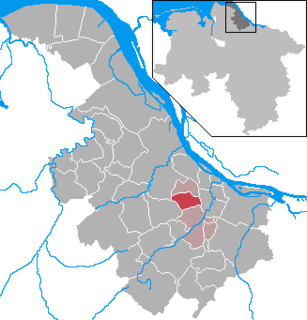
Dollern is a municipality in the district of Stade, Lower Saxony, Germany. In 2006 the population was 1,747.
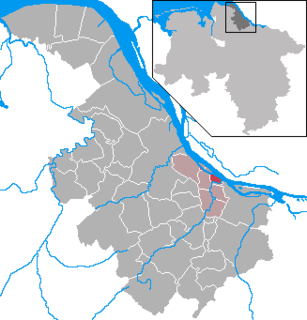
Grünendeich is a municipality in the district of Stade, Lower Saxony, Germany.
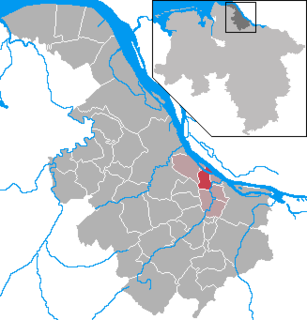
Steinkirchen is a municipality in the district of Stade, Lower Saxony, Germany.
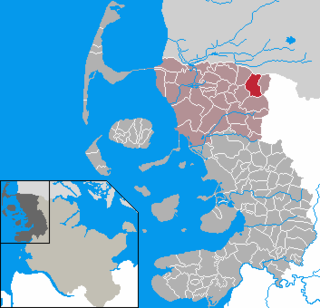
Ladelund is a municipality in the district of Nordfriesland, in Schleswig-Holstein, Germany.

Neugraben-Fischbek (help·info) is a quarter of Hamburg, Germany belongs to the borough Harburg. The quarter consists of the old settlements Neugraben and Fischbek, and the more recently constructed area Neuwiedenthal.

The Bullenhuser Damm School is located at 92–94 Bullenhuser Damm, a street in the Rothenburgsort section of Hamburg, Germany. During heavy air raids in the Second World War, many portions of Hamburg were destroyed, including the Rothenburgsort section, which was heavily damaged. The school was only slightly damaged. By 1943, the surrounding area was largely obliterated so the building was no longer needed as a school. In October 1944, a subcamp of the Neuengamme concentration camp was established in the school to house prisoners used in clearing the rubble after air raids. The Bullenhauser Damm School was evacuated on April 11, 1945. Two SS men were left to guard the school: SS Unterscharführer Johann Frahm and SS Oberscharführer Ewald Jauch, and the janitor Wilhelm Wede.

Dessauer Ufer was a subcamp of the Neuengamme concentration camp in Nazi Germany, located inside the Port of Hamburg on the Kleiner Grasbrook in Veddel. It was in operation from July 1944 to April 1945. Inmates were mostly used for forced labour at rubble clearing and building in the Hamburg port area.

Poppenbüttel is a quarter in the borough Wandsbek of Hamburg, Germany. In 2016 the population was 22,847.
Alfred Trzebinski was an SS-physician at the Auschwitz, Majdanek and Neuengamme concentration camps in Nazi Germany. He was sentenced to death and executed for his involvement in war crimes committed at the Neuengamme subcamps.

Gertrud Elli Heise was a female guard and later, SS overseer at several concentration camps during the Second World War. Heise was born in Berlin, Germany. She was tried for war crimes in 1946.
The SS-Baubrigaden were a type of subcamp of Nazi concentration camps that were first established in Autumn 1942. These units were usually made up of male non-Jewish prisoners—most were Poles or Soviets. Chances of survival were higher in these mobile units than the main camps they were attached to. The deployment of the Baubrigaden to major cities within the German Reich was the first time the German public became aware of the living conditions in concentration camps.

During World War II, the German Luftwaffe staffed dozens of concentration camps, and posted its soldiers as guards at many others. Camps created for the exploitation of forced labor for armaments production were often run by the branch of the Wehrmacht that used the products. The Wehrmacht also posted about 10,000 Wehrmacht soldiers to concentration camps because of a shortage of guards in mid-1944, including many from the Luftwaffe.
The Husum-Schwesing subcamp in the Schwesing district of Engelsburg, about five kilometres northeast of Husum, became a satellite of Neuengamme concentration camp on 26 September 1944 and was occupied by prisoners in connection with the construction of the so-called Frisian Wall (Friesenwall). Some 2,500 people from 14 countries were incarcerated here in autumn 1944; 297 prisoners died as a result of forced labour, malnutrition and abuse. The camp was closed on 29 December 1944.
